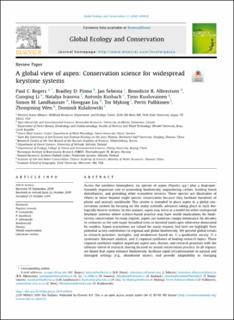| dc.description.abstract | Across the northern hemisphere, six species of aspen (Populus spp.) play a disproportionately important role in promoting biodiversity, sequestering carbon, limiting forest disturbances, and providing other ecosystem services. These species are illustrative of efforts to move beyond single-species conservation because they facilitate hundreds of plants and animals worldwide. This review is intended to place aspen in a global conservation context by focusing on the many scientific advances taking place in such biologically diverse systems. In this manner, aspen may serve as a model for other widespread keystone systems where science-based practice may have world implications for biodiversity conservation. In many regions, aspen can maintain canopy dominance for decades to centuries as the sole major broadleaf trees in forested landscapes otherwise dominated by conifers. Aspen ecosystems are valued for many reasons, but here we highlight their potential as key contributors to regional and global biodiversity. We present global trends in research priorities, strengths, and weaknesses based on, 1) a qualitative survey, 2) a systematic literature analysis, and 3) regional syntheses of leading research topics. These regional syntheses explore important aspen uses, threats, and research priorities with the ultimate intent of research sharing focused on sound conservation practice. In all regions, we found that aspen enhance biodiversity, facilitate rapid (re)colonization in natural and damaged settings (e.g., abandoned mines), and provide adaptability in changing environments. Common threats to aspen ecosystems in many, but not all, regions include effects of herbivory, land clearing, logging practices favoring conifer species, and projected climate warming. We also highlight regional research gaps that emerged from the three survey approaches above. We believe multi-scale research is needed that examines disturbance processes in the context of dynamic climates where ecological, physiological, and genetic variability will ultimately determine widespread aspen sustainability. Based on this global review of aspen research, we argue for the advancement of the “mega-conservation” strategy, centered on the idea of sustaining a set of common keystone communities (aspen) that support wide arrays of obligate species. This approach contrasts with conventional preservation which focuses limited resources on individual species residing in narrow niches. | en_US |

